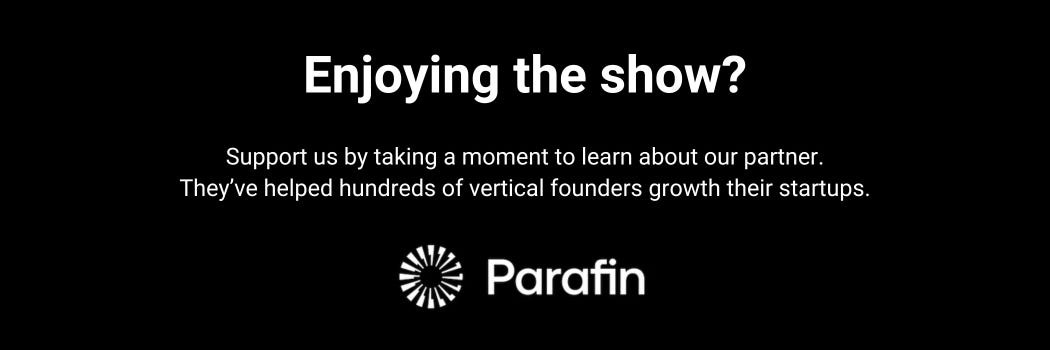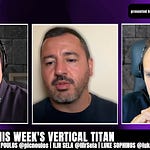Call it the “invisible TAM” strategy: find (or create) a market hiding inside a bigger category, win trust by becoming ever-present in your ICP community, then expand from software into all the transaction flows that matter. This episode wrestles with the investor psychology around what counts as a venture-scale industry, the tension between PE vs. VC growth / exit archetypes, and whether today’s AI hype masks fragile revenue.
This episode’s guest and Vertical Titan is Todd Saunders of Broadlume: a founder who pivoted from adtech to flooring (taking a huge revenue hit to do so), rolled up seven products, and built a community-led, hyper-vertical GTM machine. You’ll hear exactly how Broadlume got a foot in the door through online presence, earned the right to become the space’s OS, and hustled to become an ever-present and trusted partner in a previously tech-averse vertical.
I) Vertical Market Pulse
How to Own an Emerging Vertical: Dutchie Case Study
Dave Yuan @ Tidemark
When mainstream POS and investors avoided cannabis, Dutchie built the system of record for dispensaries and rode the category’s structural growth. The broader lesson: hidden or newly recognized industries almost always need purpose-built OS layers. Founders should look for markets that exist but aren’t psychologically “counted” as industries yet.
Category Creation in Healthcare: MoldCo’s $8M Seed
Press Release (deal led by Cantos + Collaborative Fund)
A telehealth platform for mold-related illness sounds tiny—until you realize the spend is fragmented across pulmonology, primary care, and allergy. Like Hims, MoldCo’s play is to aggregate diffuse spend into one front door. Also notable: an $8M “seed” is now normal; round labels are basically useless.
AI Frontiers: Long-Context Inference
JS Denain + Anson Ho @ Epoch AI
Huge context windows promise memory-rich agents, but training cadence, cost, and energy constraints still bottleneck progress. Expect a shift toward smaller, more efficient models and pragmatic memory architectures. For vertical founders, expanding memory means greater capabilities and vertical alignment. Implications for near-term changes in inference costs are still TBD.
II) Vertical Titan: Todd Saunders (Founder & CEO @ Broadlume)
Broadlume’s backstory
Todd Saunders didn’t start in flooring. He and his co-founder were Google alums who left in 2015 to build AdHawk, a horizontal ad-tech platform serving SMBs across dozens of categories. The business grew to meaningful revenue, but the retention problem never went away: most customers churned quickly, except for one strange outlier group — flooring retailers. Those customers stuck, expanded, and treated AdHawk like a real partner rather than a disposable tool. That signal was impossible to ignore.
In 2018, Todd leaned into the anomaly and the next few years validated his bet. Broadlume expanded its product set + rolled up key tooling across websites, CRM, ERP, visualization, and payments, layering them into a coherent ecosystem instead of a single monolith.
The result was a flywheel the team couldn’t have built in horizontal ad-tech. Retailers trusted them. Manufacturers partnered with them. Traffic across thousands of retailer websites became a distribution and monetization engine. And Broadlume grew into one of the largest platforms in the category, ultimately selling to a global strategic acquirer. The arc is a case study in what happens when founders go all-in on a vertical, aiming to be its holistic commercial infrastructure.
Community as the real GTM engine
Broadlume won by caring so much about their market that they became critical connective tissue for the industry. Todd and the team built a community moat long before the product suite was complete: anchored by a massive Facebook group where retailers debated everything from margins to merchandising. A relentless cadence of webinars, guides, how-to’s, and live conference presences helped their ICP solve real problems and make real connections.
Todd seeded the trust flywheel personally. He friended retailers on Facebook so he could invite them into the group, answered questions that had nothing to do with software, and turned conference footage into year-round content. FloorCon became a tentpole —part reunion, part rally—where customers brought families, met each other, and left trusting Broadlume more every time. As Todd puts it, community was the heart of their distribution strategy.
The impact was simple: most revenue came from warm leads, referrals, and reputation compounding inside the ecosystem. By the time Broadlume layered in outbound sales, the ecosystem had already made them the default choice in the industry. It took a while to convince floorers that this tech guy from Google was on their team, but crossing that chasm was transformational for the business.
When M&A makes sense
Broadlume’s entire trajectory changed with one early acquisition: FloorForce, a niche website and digital-services company already embedded deep in the flooring world. Its customers retained far better than AdHawk’s broader SMB base, and its team brought something Todd didn’t yet have: domain credibility and a direct line into thousands of independent retailers. Buying FloorForce gave Broadlume an immediate wedge, real distribution, and a cultural passport into a vertical where outsiders rarely get a shot. Later on, Todd would acquire seven more tools, stitching them into a vertical ecosystem: website, CRM, ERP, visualization, payments. Not perfectly unified, but integrated well enough to start, and increasingly seamless over time.
Beyond software: monetize the network
With 4,000 retailer websites and 20M consumer visits, Broadlume tested manufacturer promotions, then launched four private-label brands (no inventory) and took ~10% of sell-through. PE treats this as “weird transactional revenue,” but the operating leverage was real. Sometimes, products may not generate the highest-leverage, highest-multiple topline—but they do contribute to growth, expand the value footprint, and build platform lock-in. Just be cognizant of what’s core and what’s add-on.
Investor-founder alignment is key
Todd has some great advice on this front: as a founder, make sure you have alignment with your investors going in. E.g. a VC is likely looking to underwrite 10× with right right-tail outlier potential. PE, on the other hand, might be angling for 3× in four years, buying cash-flowing businesses at ~4–6× ARR. If your dilution makes a 4–6× exit meaningless, you’re trapped.
Vertical of choice matters
Flooring is one of the largest but least-organized corners of home improvement — tens of billions in spend, yet split across thousands of independent retailers who each run their businesses differently. TAM is huge, but the software TAM looks tiny until you realize the real opportunity sits in the transaction flow: product selection, quoting, installation, financing, and the relationships between retailers, distributors, and manufacturers.
It’s also an operationally complex vertical. Retailers manage giant SKU catalogs, variable lead times, samples, measurements, installers, and high-ticket, low-frequency purchases that require trust. Most systems of record are dated or PE-owned, meaning NPS is low and switching costs are emotional, not technical. The fragmentation plus the money running through the channel make flooring a textbook vertical where software alone may not be enough, but a one-stop-shop is.
The hardest part
Maintaining trust with SMB customers. These aren’t faceless logos — they’re family businesses. Todd had to show up in showrooms, give out his phone number, and personally defuse blowups in Facebook groups. That emotional labor is a job of its own.
Consistent acquisition strategy requires a PE mindset. Sourcing acquisitions, underwriting them, negotiating structure, integrating products and teams, and building revenue bridges. It’s a completely different muscle from SaaS operating and often in tension with product velocity.
Absorbing the demands of a growth investor. Balancing efficiency, margin, and predictability with the pressure to keep growing, while constantly aligning with investors who are playing a different “game” and time horizon.
Memorable lines from Todd
“51% of the reason people signed up was the Broadlume brand; 49% was the product.”
“Our go-to-market was content-led and community-led.”
Founder advice: “Answer the phone in English — and actually answer the phone.”
III) Vertical Playbook
Community-Driven GTM
Why it works
Hidden industries need structure. When verticals are fragmented, under-digitized, or culturally insular, the first credible operator to show up consistently becomes the OS by default.
Sub-vertical focus creates real PMF. Flooring isn’t “trades,” just like pizzerias aren’t “restaurants.” Narrow beats broad because it maps cleanly to a buyer’s daily reality. Look in mega-categories where hidden markets may be obscured; then, when it comes to product, leverage its unique needs to build trust & differentiation.
Community compresses CAC. When your market already talks to itself at trade shows, in Facebook groups, and in peer networks, becoming the connective tissue builds trust faster than any outbound team.
You monetize the flows, not the seats. Manufacturers, distributors, payments, branded product, financing — all live adjacent to the software. The platform that organizes the community earns the right to them.
AI is an internal weapon first. In many “hidden” vertical markets, customers might literally still be on pen and paper. Here, AI will excel because it gets a discrete job done, not because it’s AI. In fact, the AI branding might hurt you. Sometimes, AI’s first job is reducing your cost-to-serve. Don’t try to dazzle no-nonsense, real-economy vertical business owners with features only early adopters would lean into.
How to run it (Broadlume-inspired blueprint)
Start with a wedge that proves retention. Websites, scheduling, intake, measurement: anything that inserts you into daily workflow and earns trust fast.
Bring domain credibility from day one (or earn it through sheer presence). If you’re not an insider, act like one. Learn the craft, understand the lingo, and show up where decisions are made. In many of these markets, there’s no faster way to lose trust than to inadvertently show you know less than one of their junior employees.
Put faces on the company (CEO included). Give out your number. Answer the phone. Be visible in the places your customers already live.
Teach instead of pitch. Webinars, guides, “how to think” content, not demos masquerading as education.
Turn conferences into content factories. Capture enough stories, testimonials, and b-roll at one event to power months of distribution.
Build the community as a product. Seed the group, name it well, curate the conversation, then spotlight the best threads in newsletters and videos.
Expand through an ecosystem, not a monolith. Cross-sell what pairs naturally; integrate deeply where it matters; don’t force a platform before the market trusts you.
Monetize the value chain once your distribution flywheel is spinning. Upstream, downstream, private-label SKUs, payments, financing, procurement… these expansions / extensions only work once you own the anchor relationship in the ecosystem. Some, moreover, might be better for retention than multiples.
Keep investor alignment tight. VC and PE play different games. Don’t let your cap table trap you into an outcome that doesn’t serve you.
Founder litmus tests
Are you entering a sub-vertical incumbents don’t respect or don’t even recognize as a market?
Can you credibly become a visible community leader within 12-24 months?
Do you have a realistic plan to monetize transactions without taking inventory risk?
Given your dilution and investor mix, what exit actually works for you?
Can AI meaningfully lift your margin today, even if customers don’t touch an AI feature for years?
What we debated on-air
AI infra: bubble or overbuild?
Long-context models vs. cost/energy constraints.
Venture-speed growth vs. PE-durability expectations.
Whether to attack systems-of-record now that NPS has cratered.
Next week on Verticals
Next week, Mike Kopko at Pearl Health joins us to discuss Healthcare’s AI Moment.
If you’re building in Vertical AI (or considering it) and want a sounding board, the Euclid Ventures team would love to hear from you. DM us here on Substack or ping us on LinkedIn.











